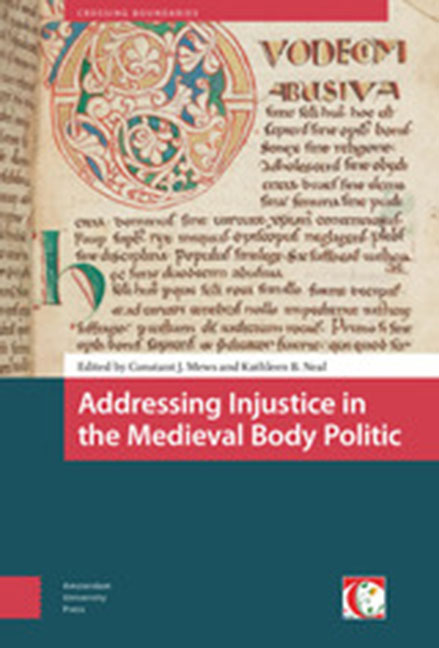Book contents
- Frontmatter
- Contents
- Acknowledgements
- Abbreviations
- Note on References
- List of Tables and Illustrations
- Introduction: Justice and its Abuse in the Medieval Body Politic
- 1 The De XII abusiuis saeculi: Contexts and Textual Traditions
- 2 The Irish Background to the De XII abusiuis saeculi
- 3 ‘Each in the Calling to Which They are Called’: Images of Authority in the De XII abusiuis saeculi
- 4 Transforming Irish Traditions: De XII abusiuis saeculi and Justice in the Frankish World, c. 750–1050
- 5 The Unjust King and the Negligent Bishop: Addressing Injustice in Eleventh and Twelfth-Century England and Germany
- 6 Reflecting on Abuses in Religious Life: From The Twelve Abuses of the Cloister to The Cloister of the Soul
- 7 Preaching the Body Politic: John of Wales and Franciscan Political Thought in the Late Thirteenth Century
- 8 Justice and Its Abuses in the Speculum justiciariorum
- 9 Addressing Abuses and Injustice in the Court of Philip the Fair: The De informatione principum of Durand of Champagne
- 10 ‘Perfect Justice Weighs Everything on a Balanced Scale’: Italian Friars on Equity, the Common Good, and the Commune c. 1270–c. 1310
- 11 Some Late Franciscan Rewritings of the Twelve Abuses
- Appendix: On the Twelve Abuses of the Age A Translation
- Bibliography
- Index of Biblical References
- Index of Manuscripts
- General Index
3 - ‘Each in the Calling to Which They are Called’: Images of Authority in the De XII abusiuis saeculi
Published online by Cambridge University Press: 14 February 2024
- Frontmatter
- Contents
- Acknowledgements
- Abbreviations
- Note on References
- List of Tables and Illustrations
- Introduction: Justice and its Abuse in the Medieval Body Politic
- 1 The De XII abusiuis saeculi: Contexts and Textual Traditions
- 2 The Irish Background to the De XII abusiuis saeculi
- 3 ‘Each in the Calling to Which They are Called’: Images of Authority in the De XII abusiuis saeculi
- 4 Transforming Irish Traditions: De XII abusiuis saeculi and Justice in the Frankish World, c. 750–1050
- 5 The Unjust King and the Negligent Bishop: Addressing Injustice in Eleventh and Twelfth-Century England and Germany
- 6 Reflecting on Abuses in Religious Life: From The Twelve Abuses of the Cloister to The Cloister of the Soul
- 7 Preaching the Body Politic: John of Wales and Franciscan Political Thought in the Late Thirteenth Century
- 8 Justice and Its Abuses in the Speculum justiciariorum
- 9 Addressing Abuses and Injustice in the Court of Philip the Fair: The De informatione principum of Durand of Champagne
- 10 ‘Perfect Justice Weighs Everything on a Balanced Scale’: Italian Friars on Equity, the Common Good, and the Commune c. 1270–c. 1310
- 11 Some Late Franciscan Rewritings of the Twelve Abuses
- Appendix: On the Twelve Abuses of the Age A Translation
- Bibliography
- Index of Biblical References
- Index of Manuscripts
- General Index
Summary
Abstract:
This chapter examines the images of authority in the De XII abusiuis saeculi. It investigates how the treatise merged both hierarchical or vertical relationships with consensus or horizontal relationships between the orders. I argue that its author drew on scripture and Pauline ideas of justice to emphasize a sophisticated model balancing personal responsibility with the need for public correction. This model of authority potentially points to the influence of the Rule of Basil and may represent a profound change in the structuring of authority in seventh-century Ireland.
Keywords: social hierarchy, scripture, early medieval Ireland, Paul of Tarsus, Basil of Caesarea, Isidore of Seville
The De XII abusiuis saeculi, or On the Twelve Abuses of the Age, is a treatise from seventh-century Ireland predominately concerned with the orders of society and the proper roles of those orders within society. Its author formulates twelve abusive expressions or abusiua to identify behaviour that undermines the Christian message. In doing so, the treatise connects abusiua to abuses of God's Law and of the divine calling of different groups within society. Failure to avoid these abuses will result in the suffocation of justice and the damnation of an entire Christian society, without recourse to a defence before the divine judge.
The treatise outlines the orders in twelve distinct categories, appearing to move from six categories of the individual—the scholar, the old, the young, the wealthy, the female, and the aristocrat—to six more ‘public’ categories—the Christian, the poor, the king, the bishop, the common folk, and the people as a whole. The rhetoric is powerfully shaped by appreciation for antithesis, pairing a positive role with the lack of a required virtue or the presence of a destructive vice. The treatise subsequently unpacks the adverse impacts of the select examples, followed by the benefits to society if virtuous behaviour is embraced and wrong behaviour is rejected. This style—whereby antithesis introduces negative criticism followed by positive example—is much favoured in an insular context. Indeed, one of the earliest surviving medieval ‘mirror for princes’, that of Gildas's De excidio Britanniae (dated variously 479–550) and critical of the behaviour of kings and clerics, adopts similarly antithetical criticism followed by positive example. It may well be useful to regard DDAS as a broader ‘mirror for society’, although structured in a more systematic fashion.
- Type
- Chapter
- Information
- Addressing Injustice in the Medieval Body Politic , pp. 87 - 110Publisher: Amsterdam University PressPrint publication year: 2023

